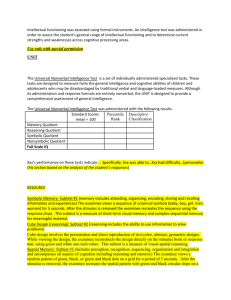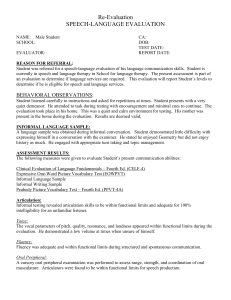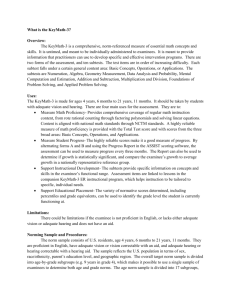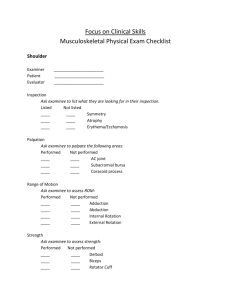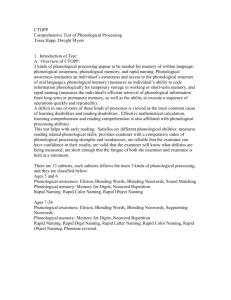TOAL - WordPress.com
advertisement
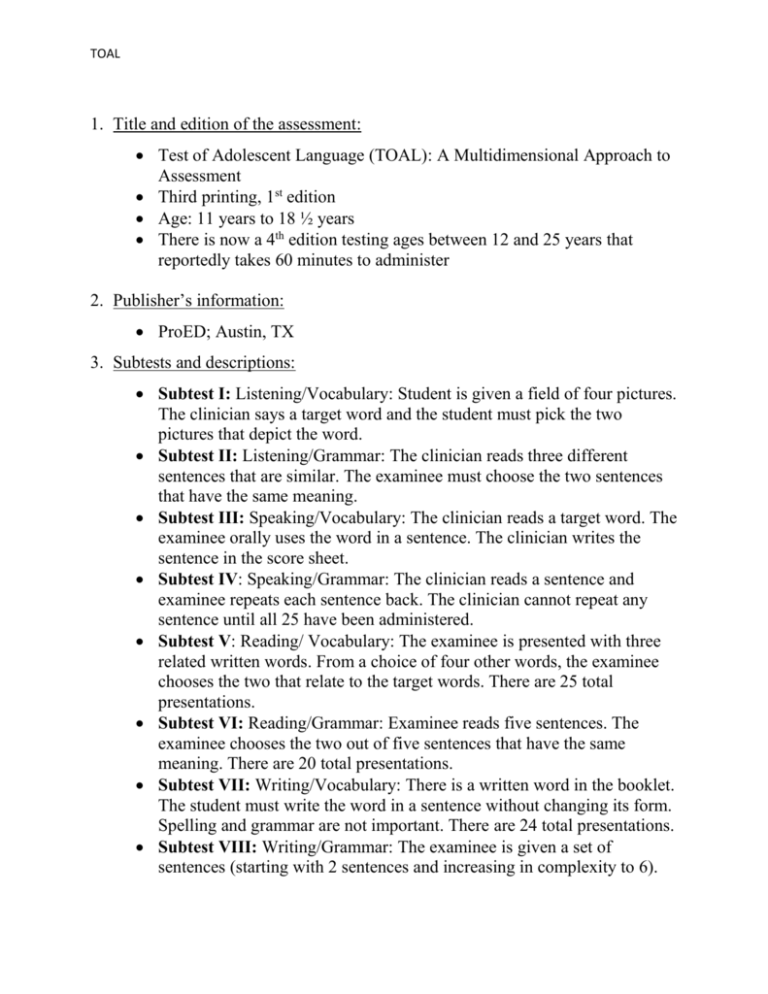
TOAL 1. Title and edition of the assessment: Test of Adolescent Language (TOAL): A Multidimensional Approach to Assessment Third printing, 1st edition Age: 11 years to 18 ½ years There is now a 4th edition testing ages between 12 and 25 years that reportedly takes 60 minutes to administer 2. Publisher’s information: ProED; Austin, TX 3. Subtests and descriptions: Subtest I: Listening/Vocabulary: Student is given a field of four pictures. The clinician says a target word and the student must pick the two pictures that depict the word. Subtest II: Listening/Grammar: The clinician reads three different sentences that are similar. The examinee must choose the two sentences that have the same meaning. Subtest III: Speaking/Vocabulary: The clinician reads a target word. The examinee orally uses the word in a sentence. The clinician writes the sentence in the score sheet. Subtest IV: Speaking/Grammar: The clinician reads a sentence and examinee repeats each sentence back. The clinician cannot repeat any sentence until all 25 have been administered. Subtest V: Reading/ Vocabulary: The examinee is presented with three related written words. From a choice of four other words, the examinee chooses the two that relate to the target words. There are 25 total presentations. Subtest VI: Reading/Grammar: Examinee reads five sentences. The examinee chooses the two out of five sentences that have the same meaning. There are 20 total presentations. Subtest VII: Writing/Vocabulary: There is a written word in the booklet. The student must write the word in a sentence without changing its form. Spelling and grammar are not important. There are 24 total presentations. Subtest VIII: Writing/Grammar: The examinee is given a set of sentences (starting with 2 sentences and increasing in complexity to 6). TOAL The student must write a single sentence that combines all important elements from the given set. The student does this independently. 1. Basal / Ceiling: Basal: for every subtest it is 5 consecutive correct responses. Ceiling: for every subtest it is 3/5 consecutive incorrect responses 2. Length of administration time: There is no time limit, but it ranges from 1-3 hours. Average time of administration is 1 hour and 45 minutes. 3. Materials needed: Student booklet Student answer booklet TOAL manual Pencils 4. Scoring procedures and scoring time: Up to 43 minutes maximum Students are given credit for all items that are below the basal. They are recorded as missing all items found above the basal. Test I, II, V, and VI are multiple choice so they would take about 5 minutes to score. Test III: about 10-15 minutes because the clinician must listen to the recorded sentences and write them down. Test IV: about 1 minute because scoring is done as test is administered. Test VII: about 5-7 minutes because clinician is judging semantic understanding. Test VIII: about 15 minutes because the clinician must analyze the original sentences and make sure the produced combination has all the critical elements of the original sentences. NOTE: The above are the maximum scoring times if examinee did not ceiling out. 5. Unique features of this assessment: Having to combine a range of sentences (up to six) TOAL Choosing two pictures that share a meaning Choosing two words that go with three others from a similar category Measures receptive and expressive language and both oral and written skills. 6. Research supporting the use of this assessment: Journal articles cited in the manual supporting the use of the subtests administered: o Wiig, E., & Semel, E. M. (1976). Language disabilities in children and adolescents. Columbus, OH: Charles E. Merrill. o Wiig, E., & Roach, M. A. (1975). Immediate recall of semantically varied “sentences” by learning-disabled adolescents. Perceptual and Motor Skills, 40, 119-125. A recent review of the newest TOAL-4 concluded test was a good measure to assess oral and written language of both genders in adolescents and young adults including varied ethnicities. However, it was not considered a reliable measure for those with ADHD or learning disability. o Hammill, , D. D., Brown, V. L., Larsen, S. C., & Wiederholt, J. L. (2007). Test of adolescent and adult language, fourth edition. TOAL-4. Retrieved from http://0search.ebscohost.com.library.uark.edu/login.aspx?direct=true&db= loh&AN=18043472&site=ehost-live&scope=site 7. Technical data that support the use of this assessment: 2723 students from 17 states and 3 Canadian provinces. Test-retest reliability is .91-.98 for 9 of the 11 quotients and .85 and .82 for the “speaking” and “listening” quotients respectively.
